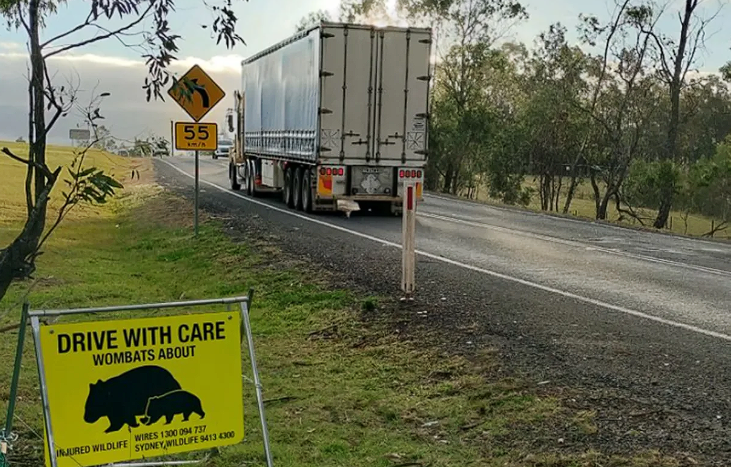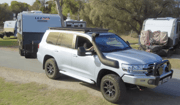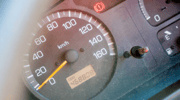
Every 3.2 seconds, an Australian native animal dies on our roads. That's a staggering 10 million creatures every year—from tiny echidnas to powerful wombats—lost to what experts are calling a national wildlife emergency.
But in the rolling hills southwest of Sydney, one council is showing how simple solutions can make a real difference.
When four fluorescent yellow signs appeared along Silverdale Road in Werombi this week, wildlife rescuer Melinda Johnstone felt like celebrating Christmas in the middle of winter.
After nearly six years of caring for injured and orphaned wombats, and watching the road toll climb relentlessly, she finally had something concrete to point to: proof that someone was listening.
A Crisis Hiding in Plain Sight
An estimated 10 million native mammals, reptiles, birds and other species are killed each year on Australian roads, according to University of Melbourne research. To put that in perspective, that's equivalent to wiping out every resident of Sydney, Melbourne, and Brisbane combined - annually.
According to AAMI, kangaroos make up over 80 per cent of all claims involving an animal, but wombats present their own unique dangers.
There are plenty of stories out there of people having not seen one crossing the road and the little guy has written off the car, which is honestly impressive for something that's the size of a medium dog.
'It honestly feels like Christmas Day. Hopefully, these guys can be an example to other councils.'
But there's more to wombat vulnerability than their solid build. These iconic marsupials are fighting a battle on two fronts - not just with traffic, but with a devastating disease that's making them sitting ducks on our roads.
When Disease Meets Danger
Sarcoptic mange is the biggest killer of wombats, and is reported to be present in 90 per cent of common wombat populations. This microscopic mite burrows under the skin, causing extreme itchiness which makes the wombat scratch, causing open wounds and scabs to form.
The cruelest twist? Mange has been shown to cause localised extinction in isolated populations, and it specifically impairs the senses wombats need most to avoid traffic. The disease thickens the skin around their ears and eyes, reducing their hearing and eyesight just when they need these senses most to detect approaching vehicles.
Why Wombats Are Especially Vulnerable on Roads
Mange affects 90 per cent of wombat populations, impairing hearing and vision
Their solid, low-slung build makes them harder for drivers to spot
They're most active at dawn and dusk - peak traffic times in rural areas
Population pressure from habitat loss forces them to cross roads more often
'One of the most horrible things that we've had happen is getting a wombat almost back to health again, and then seeing them be killed by a car,' Melinda told Yahoo News. She's witnessed the road death toll triple within 12 months in her area - a pattern being repeated across southeastern Australia.
What Actually Works (and What Doesn't)
Wollondilly Shire Council's fluorescent signs might seem simple, but they're backed by research showing signs with graphic images and variable messages get more attention, unlike standard wildlife warning signs, drivers ignore most of them after a while, making them ineffective.
The council spokesperson emphasised that 'Speed is the biggest factor for wildlife road-strike deaths' and that drivers should be especially careful 'during breeding season and when animals are more active at dawn and dusk'.
Practical Tips for Driving Through Wildlife Areas
- Reduce speed between dusk and dawn (5am-8am, 5pm-8pm peak risk times)
- If you see one animal, expect more - they rarely travel alone
- A quick toot of the horn can encourage animals to move if it's safe to do so
- Don't swerve suddenly - it's often safer to brake firmly in a straight line
- Keep passengers alert as extra spotters, especially in the front passenger seat
Research shows that expensive solutions like wildlife overpasses work well but are regarded as too costly over Australia's vast road network. Even high-tech solutions have proven disappointing - tests show the Shu-Roo signal can't be heard above road noise 50 metres away and has no effect on captive kangaroo behaviour.
How You Can Make a Difference
There's a growing citizen science movement that older Australians are perfectly positioned to join. The research specifically mentions targeting 'grey nomads' (Australian retirees who travel within their own country for an extended time) as valuable contributors to wildlife monitoring.
In Australia, wombat roadkill data is collected by the citizen science project, WomSAT, where sightings of wombat roadkill can be logged to help support the implementation of mitigation strategies.
Wildlife carers across the country are also always looking for volunteers, and many tasks don't require handling animals directly - from fundraising to community education.
The Road Ahead
Wollondilly Shire Council has welcomed the NSW Government's declaration of a new National Park to help protect habitat, showing their commitment extends beyond road signs to broader wildlife protection.
The signs installed this week are designed to be mobile, moved around by council workers or wildlife rescuers to meet demand in particular locations. It's a pragmatic approach that acknowledges limited resources while maximising impact.
Did you know?
Did you know?
Wombat burrows can house up to 10 different native species, making each wombat essentially a 'habitat engineer' for other wildlife. When we save wombats, we're protecting entire ecosystems.
As Melinda noted, 'It's not the driver's fault, they don't want to kill a wombat... now they know to be careful.' The initiative recognises that most wildlife collisions are accidents that devastate both animals and humans.
Other councils across Australia are watching Wollondilly's initiative closely. With many communities worried about the growing impacts of wildlife-vehicle collisions and desperate for solutions, simple measures like targeted signage could be rolled out more widely.
What This Means For You
The fluorescent signs might seem like a small step, but they represent something larger: recognition that our unique Australian wildlife deserves active protection, not just passive sympathy. For Melinda and countless other wildlife carers, that recognition feels like a Christmas gift indeed.
What's your experience with wildlife on rural roads? Have you noticed particular hotspots in your area where better signage might help? Share your observations in the comments below - your local knowledge could help protect the remarkable creatures that make Australia special.
Original Article
https://au.news.yahoo.com/aussie-co...bat-deadly-issue-heartbreaking-002106829.html
The Australian Roadkill Reporting Project—Applying Integrated Professional Research and Citizen Science to Monitor and Mitigate Roadkill in Australia - PMC
Cited text: Initial results indicate that mammal roadkill mostly occurs at night and that of birds and reptiles during daytime.
Excerpt: proof that someone was listening
https://pmc.ncbi.nlm.nih.gov/articles/PMC7401535/
10 million animals die on our roads each year. Here’s what works (and what doesn’t) to cut the toll : Find an Expert : The University of Melbourne
Cited text: An estimated 10 million native mammals, reptiles, birds and other species are killed each year.
Excerpt: An estimated 10 million native mammals, reptiles, birds and other species are killed each year
https://findanexpert.unimelb.edu.au...entE2 per cent80 per cent99t)-to-cut-the-toll
Roadkill: Wildlife on Our Roads - Road Sense Australia
Cited text: According to AAMI, kangaroos make up over 80 per cent of all claims involving an animal.
Excerpt: According to AAMI, kangaroos make up over 80 per cent of all claims involving an animal
https://roadsense.org.au/roadkill-wildlife-on-our-roads/
Roadkill: Wildlife on Our Roads - Road Sense Australia
Cited text: There are plenty of stories out there of people having not seen one crossing the road and the little guy has written off the car, which is honestly im...
Excerpt: There are plenty of stories out there of people having not seen one crossing the road and the little guy has written off the car, which is honestly impressive for something that's the size of a medium dog
https://roadsense.org.au/roadkill-wildlife-on-our-roads/
The Australian Roadkill Reporting Project—Applying Integrated Professional Research and Citizen Science to Monitor and Mitigate Roadkill in Australia - PMC
Cited text: Sarcoptic mange is the biggest killer of wombats, and is reported to be present in 90 per cent of common wombat populations.
Excerpt: Sarcoptic mange is the biggest killer of wombats, and is reported to be present in 90 per cent of common wombat populations
https://pmc.ncbi.nlm.nih.gov/articles/PMC7401535/
Wombat Mange FAQs | Department of Natural Resources and Environment Tasmania
Cited text:
Excerpt: extreme itchiness which makes the wombat scratch, causing open wounds and scabs to form
https://nre.tas.gov.au/wildlife-man...wombats/wombat/wombat-mange/wombat-mange-faqs
New findings to help in the fight against wombat mange
Cited text: Sarcoptic mange is caused by skin burrowing parasites and is known predominately to cause hair loss, skin thickening and death in Tasmanian bare-nosed...
Excerpt: Mange has been shown to cause localised extinction in isolated populations
https://phys.org/news/2018-04-wombat-mange.html
What works (and what doesn’t) to cut the roadkill toll- Australian Geographic
Cited text: Signs with graphic images and variable messages get more attention, but we need road trials to assess their effect on drivers and collision rates.
Excerpt: signs with graphic images and variable messages get more attention
https://www.australiangeographic.co...rks-and-what-doesnt-to-cut-the-roadkill-toll/
What works (and what doesn’t) to cut the roadkill toll- Australian Geographic
Cited text: As for standard wildlife warning signs, drivers ignore most of them after a while, making them ineffective.
Excerpt: standard wildlife warning signs, drivers ignore most of them after a while, making them ineffective
https://www.australiangeographic.co...rks-and-what-doesnt-to-cut-the-roadkill-toll/
Roadkill: Wildlife on Our Roads - Road Sense Australia
Cited text: It should come as no surprise that each year thousands of road crashes occur due to our wildlife.
Excerpt: 'Speed is the biggest factor for wildlife road-strike deaths' and that drivers should be especially careful 'during breeding season and when animals are more active at dawn and dusk'
https://roadsense.org.au/roadkill-wildlife-on-our-roads/
Roadkill: Wildlife on Our Roads - Road Sense Australia
Cited text: Dusk and dawn are when most of our native wildlife are active and when many of these incidents happen.
Excerpt: 'Speed is the biggest factor for wildlife road-strike deaths' and that drivers should be especially careful 'during breeding season and when animals are more active at dawn and dusk'
https://roadsense.org.au/roadkill-wildlife-on-our-roads/
What works (and what doesn’t) to cut the roadkill toll- Australian Geographic
Cited text: Fences and crossings do work, but are regarded as too costly over Australia’s vast road network.
Excerpt: are regarded as too costly over Australia's vast road network
https://www.australiangeographic.co...rks-and-what-doesnt-to-cut-the-roadkill-toll/
10 million animals die on our roads each year. Here’s what works (and what doesn’t) to cut the toll : Find an Expert : The University of Melbourne
Cited text: Sadly, our tests show the Shu-Roo signal can’t be heard above road noise 50 metres away and has no effect on captive kangaroo behaviour.
Excerpt: tests show the Shu-Roo signal can't be heard above road noise 50 metres away and has no effect on captive kangaroo behaviour
https://findanexpert.unimelb.edu.au...entE2 per cent80 per cent99t)-to-cut-the-toll
The Australian Roadkill Reporting Project—Applying Integrated Professional Research and Citizen Science to Monitor and Mitigate Roadkill in Australia - PMC
Cited text: This would indicate that it might be advantageous to target members of those demographic groups, such as wildlife carers, so-called grey nomads (Austr...
Excerpt: research specifically mentions targeting 'grey nomads' (Australian retirees who travel within their own country for an extended time)
https://pmc.ncbi.nlm.nih.gov/articles/PMC7401535/
Roadkill - Wikipedia
Cited text: In Australia, wombat roadkill data is collected by the citizen science project, WomSAT.
Excerpt: In Australia, wombat roadkill data is collected by the citizen science project, WomSAT, where sightings of wombat roadkill can be logged to help support the implementation of mitigation strategies
https://en.wikipedia.org/wiki/Roadkill
Roadkill - Wikipedia
Cited text: Sightings of wombat roadkill can be logged at WomSAT to help support the implementation of mitigation strategies to reduce wombat deaths.
Excerpt: In Australia, wombat roadkill data is collected by the citizen science project, WomSAT, where sightings of wombat roadkill can be logged to help support the implementation of mitigation strategies
https://en.wikipedia.org/wiki/Roadkill
Contact Us » Wollondilly Shire Council
Cited text:
Excerpt: Wollondilly Shire Council has welcomed the NSW Government's declaration of a new National Park to help protect habitat
https://www.wollondilly.nsw.gov.au/council/contact-us
10 million animals die on our roads each year. Here’s what works (and what doesn’t) to cut the toll : Find an Expert : The University of Melbourne
Cited text: Many communities are worried about the growing impacts of wildlife-vehicle collisions and are desperate for solutions.
Excerpt: many communities worried about the growing impacts of wildlife-vehicle collisions and desperate for solutions
https://findanexpert.unimelb.edu.au...entE2 per cent80 per cent99t)-to-cut-the-toll







